Starting an online store? Or do you already have one and want to try something new? An eCommerce platform is one of the fundamentals when launching and operating a website showcasing your products. Why? Because the right choice of the CMS will determine a lot of aspects:
- how much money you’ll have to pay for the needed functionality;
- whether the store will be able to grow;
- whether the platform will support your customization ideas, etc.
Magento is one of the top eCommerce platforms. Companies around the world choose it for its flexibility and unique open-source features that you won’t find anywhere else. Among the most popular Magento clients are Coca-Cola, Land Rover, Christian Louboutin, and more.
But should you opt for this platform? In this article, we’ll answer this question and provide step-by-step instructions on how to set up your first online store on Magento. So, let’s dissect Magento to understand what it is and why it can revolutionize your online business.
Introduction to Magento: What It Is and Why You Should Choose It
Put simply, Magento is an eCommerce software platform specifically designed for online stores. It’s the first thing you should install to upload product images and descriptions and customize the website user experience in line with your brand colors. Think of it as a solid ground for online stores.
Yet, Magento isn’t what you download and use as it is. It’s very dynamic and adaptable, allowing you to construct a website from the ground up using the building blocks and numerous extensions. As a result, you can get a unique store, setting you apart from the competition. The best part is that Magento can satisfy both small businesses and global brands.
Most sellers leverage Magento Open Source, a free Magento edition. Yet, it also comes in a paid form as Adobe Commerce and Adobe Commerce Cloud, with more capabilities and hosting.
Reasons to Pick Magento for Your E-commerce Site
Looking at various other alternatives, you might be thinking, “Why exactly is Magento?” Fair point! It can really be quite complicated for startups. It requires profound expertise in developing websites, so you’ll most likely need to partner with agencies providing Magento development services like Onilab. But here is why thousands of merchants worldwide opt for this CMS:
- Rich customization: Magento doesn’t limit your freedom when it comes to customization options. Whether you have a unique business model or a particular design in mind, Magento is very adaptable. You can shape and mold it to fit your vision.
- Scalability: One of the Magento strengths is the ability to scale your company. As your needs grow, the store easily adjusts to new challenges and requirements. Compared to other solutions, you can’t outgrow Magento. The Adobe Commerce Marketplace offers numerous tools and features to assist you in expanding the store.
- Robust community: Being an open-source platform, Magento boasts an active community of developers, users, and enthusiasts. They can answer your questions, help with problems, or offer their services. You can also explore other online groups uniting Magento coders besides the official forum called Magento Community.
- Extensions and plugins: If the Magento platform doesn’t have the desired feature or functionality, you can find a corresponding extension on the Adobe Commerce Marketplace. This place is abundant with plugins that can enhance your store’s capabilities.
- Security: Magento, as well as Adobe, which currently owns the platform, adheres to high security standards. It provides built-in measures, such as enhanced password management, improved cross-site scripting (XSS) attack prevention, more flexible file system ownership and permissions, etc. It always raises the bar in this department, protecting your business and customers.
Getting Started: A Step-by-Step Guide to Magento
1. Preparation Steps
Before installing and configuring Magento, you need to take care of some things. We already know that Magento is open source. It’s free. But it also means that you have to search for hosting options yourself. Magento doesn’t store your resources.
Yet, as most of Magento’s clients are large retailers with an intensive assortment of goods, they often need a reliable provider. And so do you. So, consider dedicated Magento hosting, like Nexcess or SiteGround.
You’ll also need to settle on the desired type of hosting:
- shared;
- VPS hosting;
- dedicated;
- cloud;
- managed.
Tip: Magento requires you to have PHP 7.4 or higher. Ensure the hosting vendor supports this and has a good reputation for customer support.
You’ll also need to create a domain name, set up a MySQL database for Magento, and get an SSL certificate.
2. Installation and Configuration
Next, you can proceed to install Magento from the official website. Fetch the latest version, as it guarantees you’ll have all the updates and security patches to maximize the store’s efficiency. This process can get a little tricky; that’s why it’s advisable to seek help from experienced developers.
After uploading files to the server, access your site’s URL. Here, you’ll most likely see a greeting from an installation wizard. Follow the on-screen instructions that include:
- Readiness check;
- Adding a database;
- Web configuration;
- Customizing your store;
- Creating an admin account;
- Installation.
Then comes basic store configuration, including:
- Store Admin, an interface from which you’ll manage the store. After you’ve got credentials to access the dashboard, you’ll see the Admin Panel with an overview of your recent activity, different tabs for editing the store, and a menu containing other sections and sub-sections.
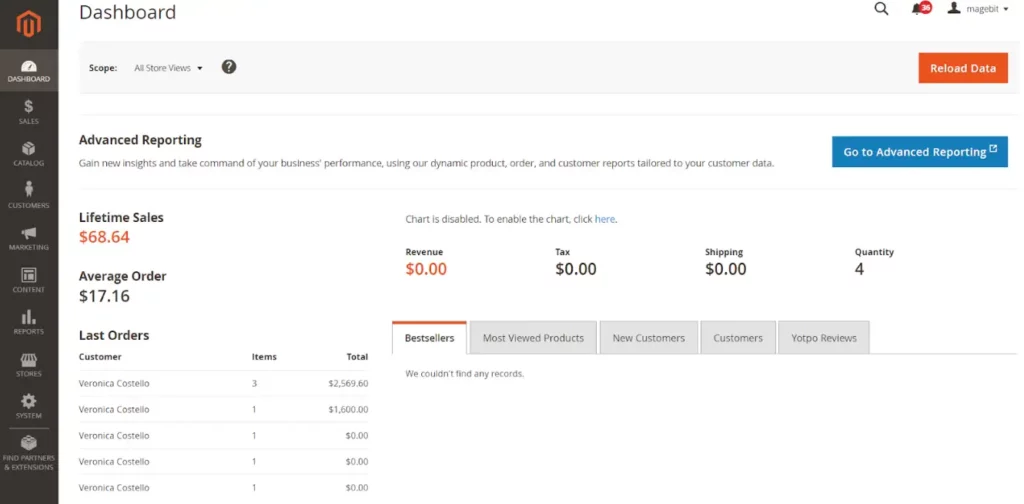
- Store details, information about your company, such as name, address, invoices, languages, currencies, and phone.
- Storefront branding, including a store logo, favicon, welcome messages, and copyright notices.
- Websites, stores, and views. Magento lets you manage several stores from a single dashboard while preserving a specific store view for each of them. For example, it can apply to various languages or designs.
3. Building Your Store
Another crucial component of an online store is its frontend, a customer-facing interface. It’s what consumers will interact with, where they’ll browse through your products and check out. You can build a custom design for your store. It’ll ensure a unique shopping experience, yet it’s more time-consuming and expensive than using ready-made templates.
Browse over 300 Magento themes and templates on ThemeForest or other websites. Take into account design responsiveness to make sure the theme adapts to various screens: desktop and mobile. Scroll through theme reviews and information like update frequency. If you’re looking for a modern and performance-oriented option, consider exploring the benefits of the Hyva theme. The Hyva theme is known for its clean design, fast loading times, and customizable features that can enhance the overall aesthetics and user experience of your Magento store.
To regulate inventory management, head to Stores -> Configuration -> Catalog -> Inventory. There, you can specify stock options, such as item status, product availability, and the display of out-of-stock products.
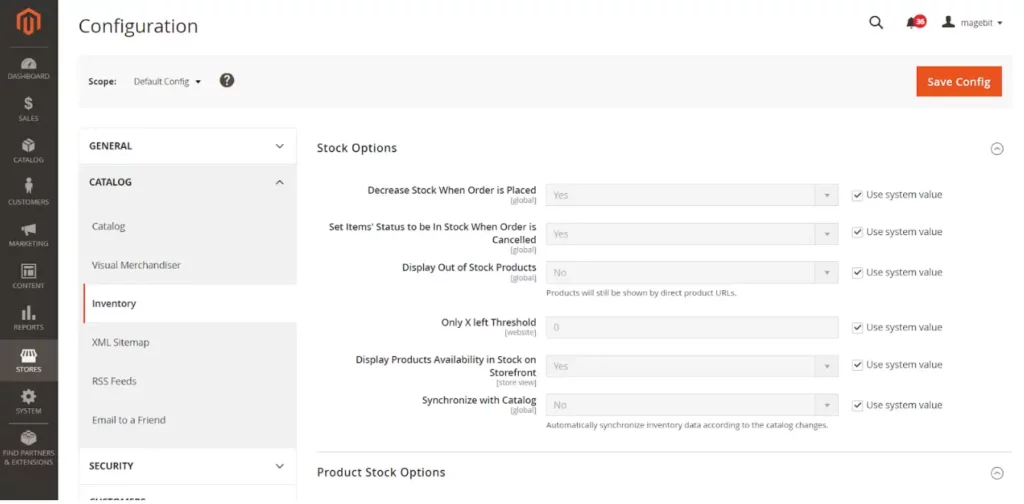
Another thing to set up is permissions for your team. You’ll have different people responsible for various tasks, so define who should have access to what to protect important data from the rest. Navigate to System -> Permissions -> All Users and create different roles (like admin, editor, etc.). Specify permissions for each role.
4. Product Management
Now, you can add content to your website, that is, products. The first step is to go to Catalog -> Categories. Here, you can add and edit your categories, like Men, Women, Kids, and others, depending on your inventory. You can add a category image and description, sort product order in the category, and change display settings.
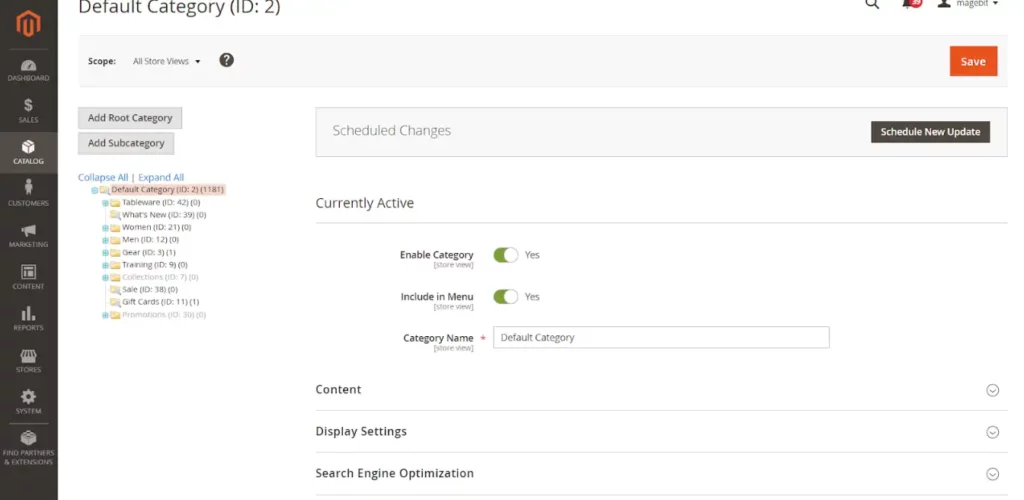
Then, add products themselves. Proceed to Catalog ->Products. Fill in the required details like name, SKU, price, and description.
Tip: The image quality affects the buying decisions, so upload high-quality product photos.
When adding products, mind search engine optimization (SEO) for product listings. It entails writing clear and descriptive product names with keywords to help search engines rank product pages effectively. But don’t stuff keywords into texts. Write enticing meta descriptions for each product to increase clicks from search results.
5. Extensions and Enhancements
A default Magento store may satisfy your needs. However, extensions can provide advanced capabilities to fulfill particular needs in the store or bring more value to what Magento can deliver. There are numerous free and paid extensions. Go straight to Adobe Commerce Marketplace to explore the available options and compare their ratings. Check their compatibility with your Magento version.
To install extensions, you’ll need to upload them to your server by adding them to the cart and proceeding to checkout. Another option is to use a ‘composer’ command to install it. Always back up your store before adding new extensions.
6. Content and Marketing
So, now you have the needed extensions. It’s time to add other content apart from products. A compelling eCommerce website doesn’t only showcase goods and services. It also tells a story through its content. For starters, create foundational pages that don’t change often, such as an About Us or Contact page. To do that, simply head over to Content and then click on Pages to begin crafting your story.
Tip: If you don’t know what to add, think of what sets you apart from others. You can place your company’s history, values, or even behind-the-scenes sneak peeks.
Not all retailers understand the power of a good blog. However, it can engage your audience, attract more customers, and improve your search engine rankings. The trick is that search engines adore new content. Therefore, maintaining an active blog can significantly increase the amount of organic traffic that comes to your store.
As far as email marketing is concerned, you can tap into a plethora of Magento extensions like Dotdigital and Mailchimp. By segmenting the audience, personalizing send-outs, and automating your campaigns, they ensure more effective strategies and a better return on investment.
Tip: Dive deeper into audience analysis to personalize not only the beginning of an email with the customer’s name. Think of product recommendations, birthday specials, or even abandoned cart reminders.
Another crucial component of the eCommerce strategy is building trust. As consumers entrust their sensitive information, they need to be sure of the data protection you provide. So, how do you foster this trust?
Secure your shopping experience by obtaining an SSL certificate. It encrypts user data between your store and the customer (making transactions secure) and gives this much-needed padlock icon. Believe it or not, this padlock can be a real game-changer in today’s age of cyber threats.
Establish clear policies to avoid unpleasant surprises. Be upfront with your refund and privacy procedures, which entails displaying them prominently on the website. It should be simple to locate and comprehend this information. Otherwise, you’ll get a disgruntled customer who feels they’ve been deceived.
7. Sales, Payments, and Shipping
When your website is ready to accept orders, it’s time to ensure that your products will sell and reach their clients without a hitch. The next step is configuring payments, creating a shipping strategy, and adjusting taxes.
For payment options, head to Stores -> Configuration -> Sales -> Payment Methods. There, you’ll see numerous payment gateways supported by Magento. Add as many methods as possible to satisfy various customers.

As for a shipping strategy, set up desired methods under Stores -> Configuration -> Sales -> Shipping Settings. You’ll probably need more options than provided out of the box if you want to ship to multiple locations while still making a profit.
Tip: One of the best strategies to increase average order value is to offer free shipping over a certain order amount (also known as free shipping threshold).
Keep in mind that countries have different tax-related legal requirements. Go to the Stores -> Taxes area to make changes.
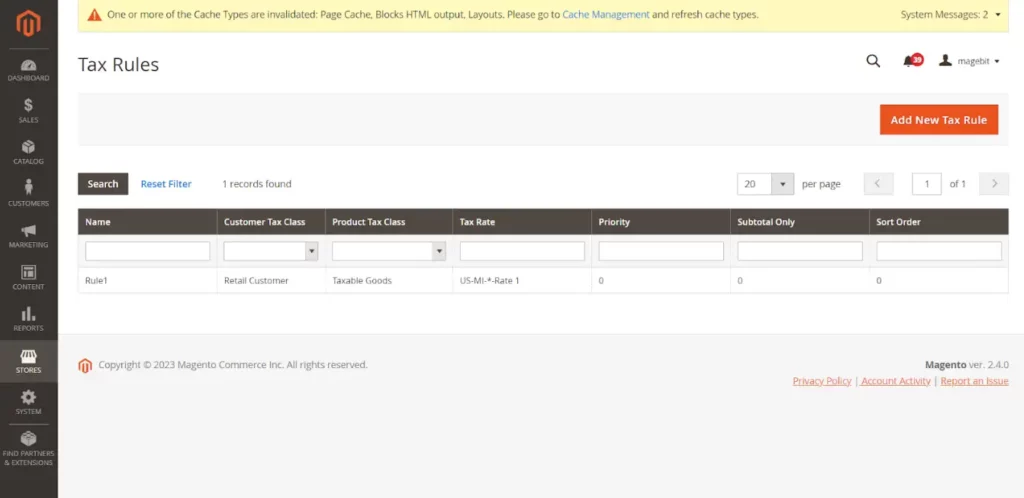
8. Optimizing Your Magento Store
Alright, let’s get down to other important stuff. You’ve set up the store, filled it with content, and even reached out to potential customers. But, like any well-oiled machine, there’s always room for fine-tuning. And that’s what optimization is all about.
SEO (Search Engine Optimization)
SEO is essentially about making your store more visible on search engines. Think of it as setting up a flashy sign for your online store in the vast mall of the internet. This strategy often requires some tools to simplify competitor, website, and keyword research.
There are several solutions out there, but Yoast SEO for Magento stands out. It’s like having a friendly guide pointing out what you’re doing right and where you could up your game. Don’t forget to whip up a sitemap—it’s basically a map that search engines use to understand and list your site.
Site Speed
Have you ever clicked on a website and then immediately clicked away because it took ages to load? That’s the kind of experience we want to avoid for your customers. Site speed is a huge factor in keeping potential customers engaged.
First of all, you need to measure your current loading speed. Leverage GTmetrix to check how the website loads and what’s slowing it down. Once you’ve determined where you stand, proceed to boost the speed. One of the tips here is to employ a CDN (Content Delivery Network). Instead of hosting the website in just one place, a CDN stores it in multiple locations worldwide. So, no matter where your customers are, they get a fast, local experience.
9. Advanced Features and Maintenance
So, you’ve built a store, and it’s running smoothly. To get the maximum out of it, you need to explore the advanced lanes of Magento. These are the features that can turn a great store into an outstanding one and keep things ticking over seamlessly.
Let’s begin with customer groups. You’ve got customers—awesome! But not all customers are created equal. That’s where ‘Customer Groups’ swoop in. Head to ‘Customers’ and then ‘Customer Groups’. Here, you can create groups like ‘Retailers’ or ‘Wholesalers’. Establishing these categories is essential as it lets you tailor pricing and perks to specific buyers.

This feature can boost loyalty, leading to more repeat business. Remember, you can shift customers between groups as their relationship with your store evolves.
Next, let’s bring up Magento API. APIs (application programming interfaces) allow Magento to “talk” to other systems. This means you can supercharge your store’s capabilities by integrating it with other platforms. Say you’ve got an ERP system. The Magento API ensures they work together in harmony. Some of the examples of possible integrations are the CreativeMinds extensions for user and supplier management.
Don’t forget that Magento contains a whole lot of data on your sales and revenue. Conduct revenue analysis in the Reports section on the main menu. There are dozens of categories there, from sales and product stats to crucial customer insights.
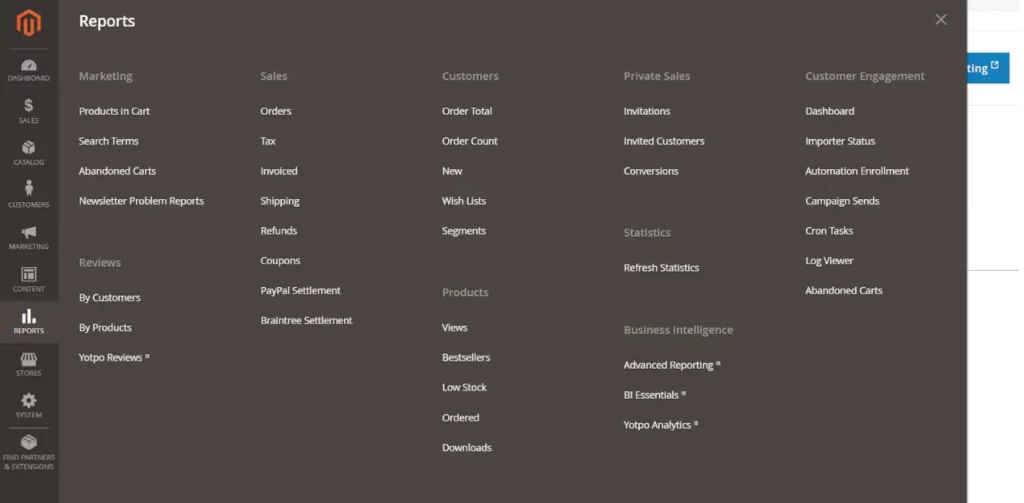
The Dashboard section in the Admin Panel will suffice for a bird’s eye view of your store’s health. But to get more comprehensive information, you can install tools like Advanced Reports by Amasty.
Documentation is another component of a properly operating store. Under the ‘Sales’ tab, you can manage all the essential docs like Invoices, Shipments, and more. But even with everything working evenly, losses are inevitable. And they hurt, especially in eCommerce.
On a positive note, you can strategize to lessen their severity or unpleasantness. For example, you can reel back in shoppers who add items to their cart and then ghost you. Managing returns effectively is another thoughtful move.
When to Consider Migrating to Magento
Whether you already have an online store or are just considering building it, Magento can seem a wonderful choice. Yet, you need to pause here. Magento is great for large enterprises with its unparalleled security, lightning-fast speed, and the ability to scale. For the same reason, it suits smaller businesses looking to grow rapidly. Magento also supports multi-store management, so you can create a unique website for a European audience and have a completely different one for Asia.
However, it’s not always reasonable to buy a spaceship if you aim to ride a bicycle. Magento can be too complicated for a newbie. You’ll have to hire professional developers involved in dedicated projects and understand eCommerce and Magento’s peculiarities. It all takes time and money.
Steep learning curve. Myriad settings. Magento seems to be carved for those business giants, growing exponentially. If you’re running a boutique store or just testing eCommerce, you might want to think twice. If you’re after simplicity, platforms like Shopify, WooCommerce, Wix, or Weebly might be more suitable for you.
Wrapping Up
Launching a Magento store isn’t limited to setup alone. It’s an ongoing process involving constant refining, optimization for search engines, leveraging advanced analytics, and so on. The platform receives updates, meaning you’ll need to learn to integrate new features and make use of them.
As mentioned above, with its robust features, Magento is perfect for large-scale businesses ready to invest time and resources. However, you should pay attention to your needs and budget when committing to this CMS. While it promises powerful capabilities, small ventures may find it too overwhelming. In conclusion, Magento is a high-grade tool in eCommerce, but ensure it aligns with your business type and readiness to invest time and money.





